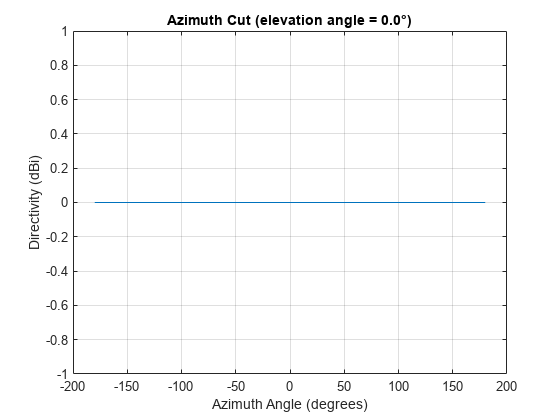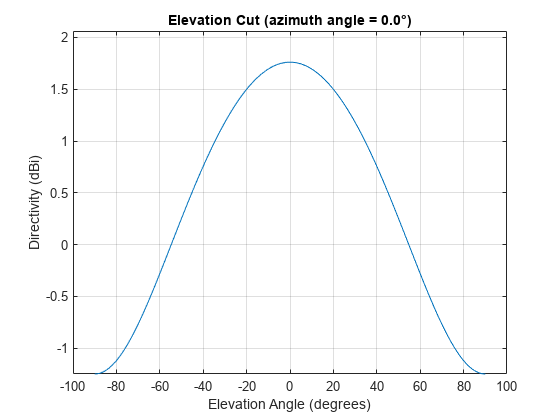pattern
System object: phased.OmnidirectionalMicrophoneElement
Namespace: phased
Plot omnidirectional microphone element directivity and patterns
Syntax
pattern(sElem,FREQ)
pattern(sElem,FREQ,AZ)
pattern(sElem,FREQ,AZ,EL)
pattern(___,Name,Value)
[PAT,AZ_ANG,EL_ANG] = pattern(___)
Description
pattern( plots
the 3-D array directivity pattern (in dBi) for the element specified
in sElem,FREQ)sElem. The operating frequency is specified
in FREQ.
pattern( plots
the element directivity pattern at the specified azimuth angle.sElem,FREQ,AZ)
pattern( plots
the element directivity pattern at specified azimuth and elevation
angles.sElem,FREQ,AZ,EL)
pattern(___,
plots the element pattern with additional options specified by one
or more Name,Value)Name,Value pair arguments.
[PAT,AZ_ANG,EL_ANG] = pattern(___)PAT. The AZ_ANG output
contains the coordinate values corresponding to the rows of PAT.
The EL_ANG output contains the coordinate values
corresponding to the columns of PAT. If the 'CoordinateSystem' parameter
is set to 'uv', then AZ_ANG contains
the U coordinates of the pattern and EL_ANG contains
the V coordinates of the pattern. Otherwise, they
are in angular units in degrees. UV units are dimensionless.
Note
This method replaces the plotResponse method.
See Convert plotResponse to pattern for
guidelines on how to use pattern in place of plotResponse.
Input Arguments
Omnidirectional microphone element, specified as a phased.OmnidirectionalMicrophoneElement System object.
Example: sElem = phased.OmnidirectionalMicrophoneElement;
Frequencies for computing directivity and patterns, specified as a positive scalar or 1-by-L real-valued row vector. Frequency units are in hertz.
For an antenna, microphone, or sonar hydrophone or projector element,
FREQmust lie within the range of values specified by theFrequencyRangeorFrequencyVectorproperty of the element. Otherwise, the element produces no response and the directivity is returned as–Inf. Most elements use theFrequencyRangeproperty except forphased.CustomAntennaElementandphased.CustomMicrophoneElement, which use theFrequencyVectorproperty.For an array of elements,
FREQmust lie within the frequency range of the elements that make up the array. Otherwise, the array produces no response and the directivity is returned as–Inf.
Example: [1e8 2e6]
Data Types: double
Azimuth angles for computing directivity and pattern, specified as a 1-by-N real-valued row vector where N is the number of azimuth angles. Angle units are in degrees. Azimuth angles must lie between –180° and 180°.
The azimuth angle is the angle between the x-axis and the projection of the direction vector onto the xy plane. When measured from the x-axis toward the y-axis, this angle is positive.
Example: [-45:2:45]
Data Types: double
Elevation angles for computing directivity and pattern, specified as a 1-by-M real-valued row vector where M is the number of desired elevation directions. Angle units are in degrees. The elevation angle must lie between –90° and 90°.
The elevation angle is the angle between the direction vector and xy-plane. The elevation angle is positive when measured towards the z-axis.
Example: [-75:1:70]
Data Types: double
Name-Value Arguments
Specify optional pairs of arguments as
Name1=Value1,...,NameN=ValueN, where Name is
the argument name and Value is the corresponding value.
Name-value arguments must appear after other arguments, but the order of the
pairs does not matter.
Before R2021a, use commas to separate each name and value, and enclose
Name in quotes.
Plotting coordinate system of the pattern, specified as the comma-separated pair consisting of
CoordinateSystem and one of "polar",
"rectangular", or "uv". When
CoordinateSystem is set to "polar" or
"rectangular", the AZ and
EL arguments specify the pattern azimuth and elevation,
respectively. AZ values must lie between –180° and 180°.
EL values must lie between –90° and 90°. If
CoordinateSystem is set to "uv",
AZ and EL then specify
U and V coordinates, respectively.
AZ and EL must lie between -1 and
1.
Example: "uv"
Data Types: char
Displayed pattern type, specified as the equal-sign-separated pair consisting of
Type and one of
"directivity"— directivity pattern measured in dBi."efield"— field pattern of the sensor or array. For acoustic sensors, the displayed pattern is for the scalar sound field."power"— power pattern of the sensor or array defined as the square of the field pattern."powerdb"— power pattern converted to dB.
Example: "powerdb"
Data Types: char
Display normalized pattern, specified as the comma-separated pair consisting of
Normalize and a Boolean. Set this parameter to
true to display a normalized pattern. This parameter does not
apply when you set Type to "directivity".
Directivity patterns are already normalized.
Data Types: logical
Output Arguments
Examples
Construct an omnidirectional microphone and plot the magnitude and directivity patterns. The microphone operating frequency spans the range 20 to 20000 Hz.
Construct the omnidirectional microphone.
sOmni = phased.OmnidirectionalMicrophoneElement(... 'FrequencyRange',[20 20e3]);
Plot the microphone magnitude pattern at 200 Hz.
fc = 200; pattern(sOmni,fc,[-180:180],0,... 'CoordinateSystem','rectangular',... 'Type','efield')

Plot the microphone directivity.
pattern(sOmni,fc,[-180:180],0,... 'CoordinateSystem','rectangular',... 'Type','directivity')

The directivity is 0 dbi as expected for an omnidirectional element.
Construct an omnidirectional microphone with response in the frequency range 20-20000 Hz. Then, plot the 3-D magnitude pattern over a range of angles.
Construct the microphone element.
sOmin = phased.OmnidirectionalMicrophoneElement(... 'FrequencyRange',[20 20e3]);
Plot the 3-D pattern at 500 Hz between -30 to 30 degrees in both azimuth and elevation in 0.1 degree increments.
fc = 500; pattern(sOmin,fc,[-30:0.1:30],[-30:0.1:30],... 'CoordinateSystem','polar',... 'Type','efield')

Create a crossed-dipole antenna. Assume the antenna works between 1 and 2 GHz and its operating frequency is 1.5 GHz. Then, plot the directivity at a constant azimuth of .
antenna = phased.CrossedDipoleAntennaElement('FrequencyRange',[1e9 2e9]); fc = 1.5e9; pattern(antenna,fc,0,-90:90,'Type','directivity', ... 'CoordinateSystem','rectangular')

The directivity is maximum at elevation and attains a value of approximately 1.75 dB.
More About
Directivity describes the directionality of the radiation pattern of a sensor element or array of sensor elements.
Higher directivity is desired when you want to transmit more radiation in a specific direction. Directivity is the ratio of the transmitted radiant intensity in a specified direction to the radiant intensity transmitted by an isotropic radiator with the same total transmitted power
where Urad(θ,φ) is the radiant intensity of a transmitter in the direction (θ,φ) and Ptotal is the total power transmitted by an isotropic radiator. For a receiving element or array, directivity measures the sensitivity toward radiation arriving from a specific direction. The principle of reciprocity shows that the directivity of an element or array used for reception equals the directivity of the same element or array used for transmission. When converted to decibels, the directivity is denoted as dBi. For information on directivity, read the notes on Element Directivity and Array Directivity.
For antenna, microphone, and array System objects, the pattern method
replaces the plotResponse method. In addition, two new simplified
methods exist just to draw 2-D azimuth and elevation pattern plots. These methods are
patternAzimuth and patternElevation.
The following table is a guide for converting your code from
using plotResponse to pattern.
Notice that some of the inputs have changed from input arguments to Name-Value pairs
and conversely. The general pattern method syntax
is
pattern(H,FREQ,AZ,EL,'Name1','Value1',...,'NameN','ValueN')
| plotResponse Inputs | plotResponse Description | pattern Inputs | ||||||||||||||||||||
|---|---|---|---|---|---|---|---|---|---|---|---|---|---|---|---|---|---|---|---|---|---|---|
H argument | Antenna, microphone, or array System object. | H argument (no change) | ||||||||||||||||||||
FREQ argument | Operating frequency. | FREQ argument (no change) | ||||||||||||||||||||
V argument | Propagation speed. This argument is used only for arrays. | 'PropagationSpeed' name-value pair. This
parameter is only used for arrays. | ||||||||||||||||||||
'Format' and 'RespCut' name-value
pairs | These options work together to let you create a plot
in angle space (line or polar style) or UV space.
They also determine whether the plot is 2-D or 3-D. This table shows
you how to create different types of plots using
|
If you set | ||||||||||||||||||||
'CutAngle' name-value pair | Constant angle at to take an azimuth or elevation cut. When
producing a 2-D plot and when 'RespCut' is set
to 'Az' or 'El', use 'CutAngle' to
set the slice across which to view the plot. | No equivalent name-value pair. To create a cut, specify either AZ or EL as
a scalar, not a vector. | ||||||||||||||||||||
'NormalizeResponse' name-value pair | Normalizes the plot. When 'Unit' is set
to 'dbi', you cannot specify 'NormalizeResponse'. | Use the | ||||||||||||||||||||
'OverlayFreq' name-value pair | Plot multiple frequencies on the same 2-D plot. Available only
when 'Format' is set to 'line' or 'uv' and 'RespCut' is
not set to '3D'. The value true produces
an overlay plot and the value false produces a
waterfall plot. |
The values | ||||||||||||||||||||
'Polarization' name-value pair | Determines how to plot polarized fields. Options are 'None', 'Combined', 'H',
or 'V'. | 'Polarization' name-value pair determines
how to plot polarized fields. The 'None' option
is removed. The options 'Combined', 'H',
or 'V' are unchanged. | ||||||||||||||||||||
'Unit' name-value pair | Determines the plot units. Choose 'db', 'mag', 'pow',
or 'dbi', where the default is 'db'. |
| ||||||||||||||||||||
'Weights' name-value pair | Array element tapers (or weights). | 'Weights' name-value pair (no change). | ||||||||||||||||||||
'AzimuthAngles' name-value pair | Azimuth angles used to display the antenna or array response. |
| ||||||||||||||||||||
'ElevationAngles' name-value pair | Elevation angles used to display the antenna or array response. |
| ||||||||||||||||||||
'UGrid' name-value pair | Contains U coordinates in UV-space. |
| ||||||||||||||||||||
'VGrid' name-value pair | Contains V-coordinates in UV-space. |
|
Version History
Introduced in R2015a
See Also
MATLAB Command
You clicked a link that corresponds to this MATLAB command:
Run the command by entering it in the MATLAB Command Window. Web browsers do not support MATLAB commands.
Seleccione un país/idioma
Seleccione un país/idioma para obtener contenido traducido, si está disponible, y ver eventos y ofertas de productos y servicios locales. Según su ubicación geográfica, recomendamos que seleccione: .
También puede seleccionar uno de estos países/idiomas:
Cómo obtener el mejor rendimiento
Seleccione China (en idioma chino o inglés) para obtener el mejor rendimiento. Los sitios web de otros países no están optimizados para ser accedidos desde su ubicación geográfica.
América
- América Latina (Español)
- Canada (English)
- United States (English)
Europa
- Belgium (English)
- Denmark (English)
- Deutschland (Deutsch)
- España (Español)
- Finland (English)
- France (Français)
- Ireland (English)
- Italia (Italiano)
- Luxembourg (English)
- Netherlands (English)
- Norway (English)
- Österreich (Deutsch)
- Portugal (English)
- Sweden (English)
- Switzerland
- United Kingdom (English)